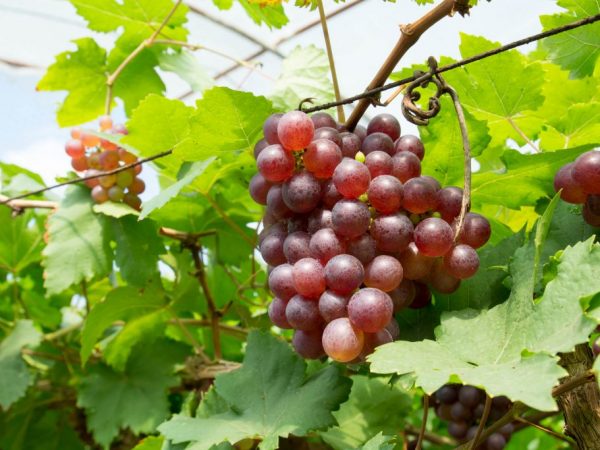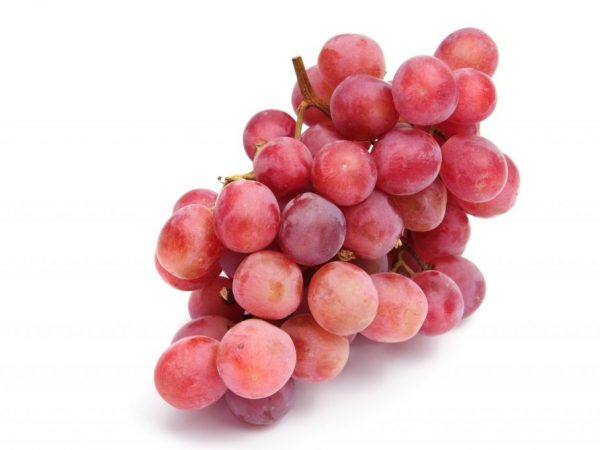Description of grapes Minsk pink
Minsk pink grapes have useful qualities and dietary properties to a greater extent than other varieties. It is based on the varieties of the metal variety.

Description of grapes Minsk pink
Characteristics of the variety
Minsk pink grapes were bred by scientists-breeders of the Institute of Biology Savchenko, Govorukhin and Rybakov in Belarus in 1952. Officially included in the State Register of Trees and Shrubs in 2005. In the register it is listed under the name "Minsk hybrid".
The variety has a number of distinctive qualities:
- frost resistance (withstands up to -30 ° C);
- annual fruiting;
- good survival rate;
- early ripening;
- resistance to fungal diseases;
- wonderful taste.
Full ripening occurs 3 months after bud break. Harvesting begins in the first days of September. The yield reaches 3.5 kg per bush.
Description of the vine
This culture is grown throughout the country, in different climatic conditions, thanks to its qualities and universal purpose:
- tall, vigorous bush;
- shoots ripen well;
- medium leaf, rounded;
- flowers are bisexual;
Fruiting of shoots reaches 55-60%. There are 1-2 inflorescences on the shoot. The bisexual flowers provide high yields annually.
Leaves of Minsk pink grapes with sharp teeth along the edges, three-toed and slightly indented. On their outer side there are irregularities, on the inner surface they are covered with hairs with a slight whitish coating.
Because of the beauty of the vines and leaves, bushes are used in landscape design, to decorate summer pavilions or fences.
Description of the fruit cluster
The fruit cluster of ripe Minsk grapes looks attractive. According to the description of the pink Minsky grape variety:
- the bunch is evenly filled;
- high density;
- bunch weight up to 300 g;
- pink colour;
- berry weight 2, 8-3 g;
- the skin is dense;
- the pulp is pink, slimy.
Sugar content reaches 25%, with low acidity. The pulp has a balanced taste, leaving a pleasant strawberry aftertaste. The skin crunches pleasantly on the teeth.
Disadvantages of the variety

Berries do not tolerate transportation well
This variety has several disadvantages. These include susceptibility to viral diseases and gray mold. It does not tolerate long-term transportation, the berries crumple and begin to rot. Grapes are best sold in the area where they are grown.
The size of the ripe berries is small; when overripe, the brush is located towards the pea. The crop is not stored on the vine; it is harvested immediately.
The tendency to overload requires increased attention when forming bushes, when pruning.
Eating
This hybrid has a high sugar accumulation, and it is used for the production of premium wine, which has an excellent taste and rich original aroma.
The Belarusian subspecies is an excellent raw material for freshly squeezed juices or for preparing them for the winter.It will be of great benefit when consumed fresh because of its content, rich in vitamins, trace elements and minerals.
In the confectionery industry, it is used to create jams, jellies and marmalades. It is used in baked goods as a natural flavoring agent.
Studies have shown that this species is more beneficial than lighter hybrids. It has anticarcinogenic and antioxidant effects on the human body. Rose Minsk variety has an invaluable healing effect on the human heart and blood vessels.
Growing features
A feature of cultivation and planting is that any soil is suitable for Minsk, but it grows better on black soil. If there is no way to plant in black soil, the soil is fertilized beforehand.
Planting goes well both in spring and autumn. The bushes will take root and bring the first harvest in 3 years. After planting, fertilizer is applied to the soil. In the next 2-3 years, they do not feed. Fertilizers are applied 2-3 r. per year after 3 years of grape life. Mineral additives and organic matter are used for feeding.
Mulching and timely feeding will preserve the strength and immunity of the plant.
For better ventilation, grape shoots are tied up and thinned out. Regular weeding in the root zone will prevent weeds from sucking nutrients out of the soil and weakening the horse system.
Winter preparation and pruning
In cold regions - in the north of the country - the vine is prepared for the winter period, despite its frost resistance.
She is removed from the support, tilted to the ground and tied together. After that, cover with a light covering material (spruce branches or leaves). Sprinkle with earth is not required. In the spring, they remove the shelter and prune up to 6-7 eyes on the shoots, and leave up to 30 eyes on the vine.
Disease prevention
The variety is resistant to various kinds of diseases, if all requirements are met during its cultivation. This is a great advantage over other species.
For prophylaxis, several treatments are carried out with solutions of fungicides on the sheet. This is done three times: during the stormy growing season, before flowering and at the time of tying the peas.
Conclusion
Due to its positive qualities, unpretentiousness and frost resistance, this early hybrid compares favorably with others. Its berries make excellent homemade wine and healthy juice. To harvest a healthy and rich crop, you must follow the minimum growing rules.


